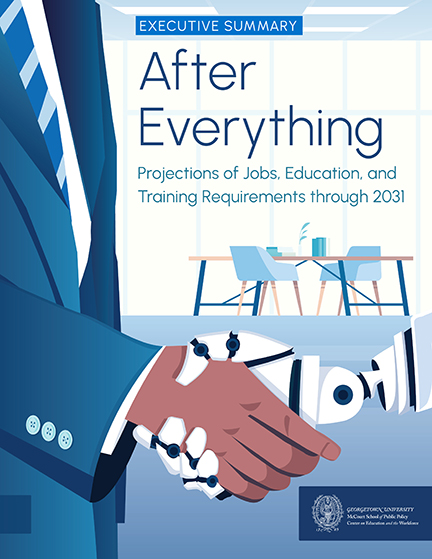Amid national discussions on the value of higher education — and whether college is even needed to land family-sustaining jobs — a new report puts it plain and simple: nearly three-fourths (72%) of all U.S. jobs through 2031 will require postsecondary education or training.
In 2021, there were 155 million jobs in the U.S., of which 68% required at least some postsecondary education; By 2031, there will be almost 171 million jobs in the U.S. economy, and employers will require college degrees or other postsecondary preparation from 72% of their new and replacement hires, predicts the Georgetown University Center on Education and the Workforce (CEW). About 29% of the jobs will require some college or an associate degree, with 42% requiring a baccalaureate or higher, and 28% requiring at least a high school education.
“These latest projections demonstrate the central role postsecondary education plays in preparing the workforce of the future, despite the fact that young people increasingly doubt the value of college and postsecondary enrollments continue to decline,” says the report, which includes a national overview of job projections and their educational requirements across industries, occupational clusters and detailed occupational groups. CEW also provides a state-by-state analysis.
Anthony P. Carnevale, CEW director and lead author on the report, said the growing doubt about the value of a college credential is “alarming,” but the data show credentials are critical.
“Our findings show, once again, that postsecondary education and training has become the threshold requirement for access to middle-class status and earnings,” he said in a release. “It is no longer the preferred pathway to middle-class jobs; it is increasingly the only pathway.”
The education requirements align roughly with the skills required: managerial and professional jobs — white-collar jobs — mainly require a bachelor’s degree or higher, while blue-collar, low-skills jobs usually only require a high school diploma or less, but even those jobs are increasingly requiring at least some postsecondary education, the report says. Community colleges typically address the education and training for mostly middle-skills jobs.
All industries are expected to see increases in employment between 2021 and 2031, but healthcare services, professional and business services, government and public education services, and leisure and hospitality services will grow the fastest, CEW predicts. Healthcare services and personal services will each have the greatest share of middle-skills job openings (36%), and healthcare services will have the most annual job openings for middle-skills workers (1.2 million), it adds.
CEW says two factors are driving the need for more education: First, the fastest-growing industries require workers with disproportionately higher education levels compared to industries with slower growth; and second, occupations as a whole are steadily requiring more education as tasks within occupations become more complex.
The report also addresses how technology may alter the workforce. Automation will mainly nix specific tasks within jobs rather than eliminate entire jobs, it says. CEW expects 28% of all tasks in current jobs — not 28% of jobs — will be at risk of automation by 2031.


